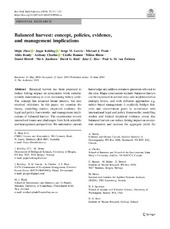| dc.contributor.author | Zhou, Shijie | |
| dc.contributor.author | Kolding, Jeppe | |
| dc.contributor.author | Garcia, Serge M. | |
| dc.contributor.author | Plank, Michael J. | |
| dc.contributor.author | Bundy, Alida | |
| dc.contributor.author | Charles, Anthony | |
| dc.contributor.author | Hansen, Cecilie | |
| dc.contributor.author | Heino, Mikko Petteri | |
| dc.contributor.author | Howell, Daniel | |
| dc.contributor.author | Jacobsen, Nis S. | |
| dc.contributor.author | Reid, David G. | |
| dc.contributor.author | Rice, Jake C. | |
| dc.contributor.author | van Zwieten, Paul A.M. | |
| dc.date.accessioned | 2019-11-19T12:32:25Z | |
| dc.date.available | 2019-11-19T12:32:25Z | |
| dc.date.issued | 2019-06-11 | |
| dc.Published | Zhou S, Kolding J, Garcia SM, Plank MJ, Bundy A, Charles A, Hansen C, Heino M, Howell D, Jacobsen NS, Reid DG, Rice JC, van Zwieten PA. Balanced harvest: concept, policies, evidence, and management implications. Reviews in Fish Biology and Fisheries. 2019;29(3):711-733. | eng |
| dc.identifier.issn | 1573-5184 | en_US |
| dc.identifier.issn | 0960-3166 | en_US |
| dc.identifier.uri | http://hdl.handle.net/1956/21011 | |
| dc.description.abstract | Balanced harvest has been proposed to reduce fishing impact on ecosystems while simultaneously maintaining or even increasing fishery yield. The concept has attracted broad interest, but also received criticisms. In this paper, we examine the theory, modelling studies, empirical evidence, the legal and policy frameworks, and management implications of balanced harvest. The examination reveals unresolved issues and challenges from both scientific and management perspectives. We summarize current knowledge and address common questions relevant to the idea. Major conclusions include: balanced harvest can be expressed in several ways and implemented on multiple levels, and with different approaches e.g. métier based management; it explicitly bridges fisheries and conservation goals in accordance with international legal and policy frameworks; modelling studies and limited empirical evidence reveal that balanced harvest can reduce fishing impact on ecosystem structure and increase the aggregate yield; the extent of balanced harvest is not purely a scientific question, but also a legal and social choice; a transition to balanced harvest may incur short-term economic costs, while in the long-term, economic results will vary across individual fisheries and for society overall; for its application, balanced harvest can be adopted at both strategic and tactical levels and need not be a full implementation, but could aim for a “partially-balanced” harvest. Further objective discussions and research on this subject are needed to move balanced harvest toward supporting a practical ecosystem approach to fisheries. | en_US |
| dc.language.iso | eng | eng |
| dc.publisher | Springer | en_US |
| dc.rights | Attribution CC BY 4.0 | eng |
| dc.rights.uri | http://creativecommons.org/licenses/by/4.0/ | eng |
| dc.subject | Ecosystem approach to fishery | eng |
| dc.subject | Ecological effect | eng |
| dc.subject | Ecosystem structure | eng |
| dc.subject | Fishing intensity | eng |
| dc.subject | Production | eng |
| dc.subject | Selectivity | eng |
| dc.subject | Sustainability | eng |
| dc.title | Balanced harvest : concept, policies, evidence, and management implications | en_US |
| dc.type | Peer reviewed | |
| dc.type | Journal article | |
| dc.date.updated | 2019-08-14T08:58:13Z | |
| dc.description.version | publishedVersion | en_US |
| dc.rights.holder | Copyright 2019 The Author(s) | en_US |
| dc.identifier.doi | https://doi.org/10.1007/s11160-019-09568-w | |
| dc.identifier.cristin | 1710517 | |
| dc.source.journal | Reviews in Fish Biology and Fisheries | |

